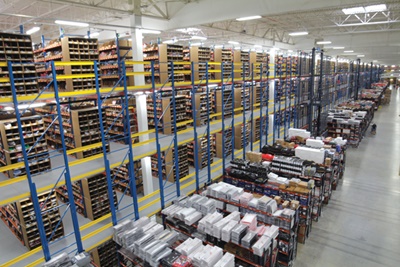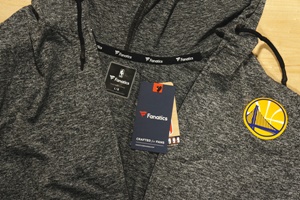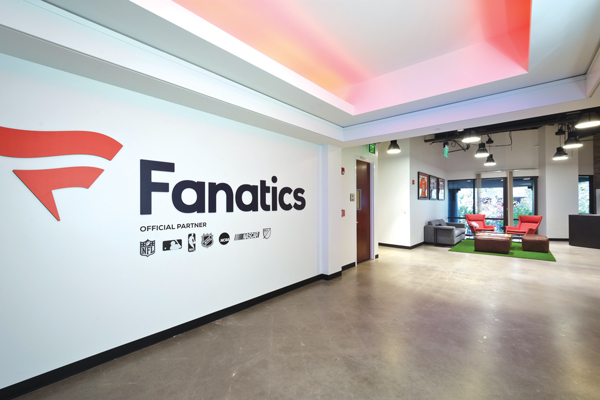 |
ABOVE: Fanatics’ West Coast headquarters in San Mateo, Calif.
BELOW: The company is building distribution centers like this one in Ohio.
Photos by: COURTESY OF FANATICS (2)
|
In an era touting disruption, one company in sports is emerging as the ultimate disrupter.
In a short period of time, Fanatics has rocked the traditionally sleepy licensing industry through its aggressive acquisition and distribution strategy, to the point where competitors sarcastically refer to the company as simply “the F word.”
In roughly five years, Fanatics has grown from an e-commerce back-end provider to leagues into their most powerful licensee. By amassing licensing rights across colleges, Major League Baseball, NASCAR, the NBA, NHL, NFL and NFL Players Association, ranging from on-field to replica jerseys; building a venue merchandise business at NASCAR tracks and across various arenas and stadiums; and attracting equity investments from some of the leagues — the NFL, MLB and NHL — with which it does business, Fanatics is now a buyer, seller and manufacturer of sports-licensed goods.
Individually, none of those concepts are new. Adopting them simultaneously certainly is, and it has roiled the $18 billion sports licensing industry at a time when the consolidation of sports specialty retail was already producing shock waves.
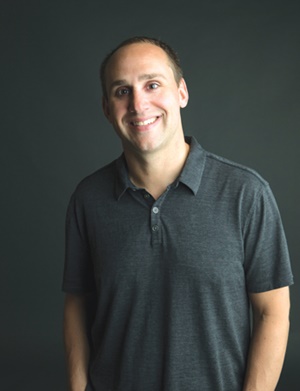 |
Fanatic Chairman Michael Rubin
Photo by: FANATICS |
“We’re at the beginning of a completely different business model for sports licensing,’’ said former MLB Properties President Rick White, now president of the Atlantic League. “You may not recognize it a year from now.’’
Fanatics is a looming presence to many who have grown up in the tightly knit business of sports licensing. These are companies used to taking dictates from the leagues, even as they pay them hefty guarantees and royalties. But kowtowing to another licensee? Unheard of. Now they are trying to figure out what the future will be of what was a reliably structured business — and whether Fanatics will be a customer, a retailer, a competitor or all of those.
In his first lengthy sit-down in more than a year, Michael Rubin, Fanatics founder and chairman, spoke with SBJ Editor-at-Large Terry Lefton in Houston on the Friday before Super Bowl LI and discussed how Fanatics is redefining sports licensing.
■ Fanatics’ share of the domestic sports licensing business is certainly growing. Is the overall sports licensing business?
RUBIN: There’s been modest growth, but it’s been more about prices increasing than units sold increasing and that concerns me. … I don’t think about us being part of a $25 billion global (licensing business), we’re really part of a $1.5 trillion global apparel business. It can’t just be about Fanatics taking share in the licensed business. The most important thing I can do is figure out how to grow our share of that larger number. So it’s how we can get a bigger share of the closet. Total units sold in licensed are still about what they were 10 years ago.
■ So, how will you grow the business?
RUBIN: Our North American e-commerce business is about 80 percent plus of our revenue today. We’ve had growth in the venue merchandising business, and frankly, we were asked by team owners and leagues to do that and offer a real multi-channel experience. That’s been a big expansion.
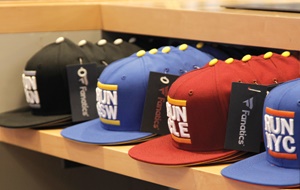 |
Fanatics-branded hats done in collaboration with Run DMC at the flagship NBA Store in NYC, and a Golden State Warriors hoodie with Fanatics tagging
Photo by: COURTESY OF FANATICS
|
We’re also growing in the wholesale sales of licensed product, which is really becoming a significant portion of our business. It’s still the biggest share of the licensed sports business today, even though e-commerce has grown from not meaningful to maybe 30 percent or more today, and maybe venue sales are another 10 percent. That still means brick-and-mortar is the biggest portion of the business and something we’re really going after.
When we think about keys to growth, the first is getting the supply chain right. The internet is
great for this business, because it can meet the insatiable desire of fans. So if we get that right, we will be able to get any merchandise the fans want at any time. Getting to that point is a massive opportunity.
That leads to creating merchandise that we wouldn’t be able to produce or sell without an advanced supply chain. Servicing micro-moments with on-demand product is such a huge opportunity.
The other way for us to grow is through data and analytics. This year, we’ll do something like 30 million orders, out of 750 million visits to our sites. Taking all the data and using it to personalize the (online) shopping experience is getting interesting.
■ So, revenue is good, what about the bottom line?
RUBIN: From 2010 to last year, we grew Fanatics’ sports licensed business 5x. We’re not making that much more on the bottom line, because we are investing like crazy. … We’re going to spend around $100 million on technology this year. We’re continuing to build regional distribution warehouses around the country at $25 million to $30 million a pop. We didn’t have anyone in San Francisco three years ago; now we have 300 (people). … You never know what teams are going to win or lose, so creating a faster supply chain is critical — that’s a big investment.
■ How much of the domestic sports licensed business is online and how big do you believe that could get?
RUBIN: Domestic, it’s around $18 billion. With maybe $5 billion of that online. Trading cards and video games have been pushing that number and they are not necessarily core to us today. So, let’s call it 30 percent online today, eventually getting to 50 percent long term. (Brick-and-mortar) stores are always going to be important in this business, they’re just going to be less important.
■ Perception/reality question: The perception is that you are losing money and buying market share. What’s the reality?
RUBIN: We’re profitable. Last year, we did over $1.4 billion and this year we’ll have another big year. … I hope it’s 30 or 40 percent bigger. … We’ve been profitable since 2011, but we’re still in an investment mode.
■ We continue to hear your IPO is coming next year …
RUBIN: There’s no such timeline. Not only has no one been hired to do that, there hasn’t even been a discussion. … Do I believe that eventually there will be an IPO? Yes. I own 70 percent myself. I want to keep building and we are in no rush to go public. It’s at least a few years out. But do I think we will end up as a public company? Highly likely.
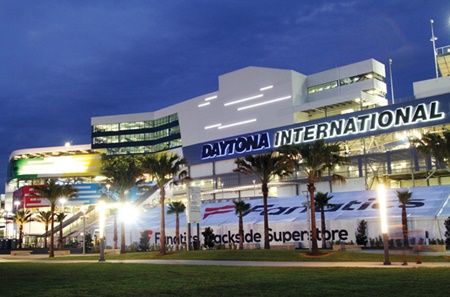 |
Fanatics' trackside Superstore at Daytona International Speedway last July
Photo by: COUTESY OF FANATICS
|
■ Where are you in terms of building the company?
RUBIN:
If I were to compare us to a baseball game, I’d say we are still in the second inning. The only business we are at all advanced in is our North American e-commerce business. Maybe we’re in the fifth inning there. We’re in the embryonic stages elsewhere. …
Last year, we did $1.4 billion in revenue. This year, we’ll grow that and that’s with barely 10 percent market share of the overall U.S. sports licensed category, and in global, we may be 6 or 7 percent. So, I think of ourselves as a gnat within a giant industry.
■ With brick-and-mortar retail influence decreasing, what will the licensed-product retailer of the future look like?
RUBIN: I don’t think it will be a standalone licensed store. It will be your best retailers, like Dick’s, doing a good job within their stores. … From a marketing perspective, those (sports specialty) retailers need the licensed category for the consumer connection.
■ The thing that I hear the most complaints about are internet distribution policies, in which you restrict sales to particular sites, mostly your own. Where do you stand on that?
RUBIN: I don’t think we stand anywhere — it’s the leagues’ policies. All the leagues and teams are focused on building their direct-to-consumer businesses. They are doing that in media, where they’ve all built their own TV networks. They’ve built, or are building, their own OTTs and ticket exchanges. Merchandise is no different. They want to deal directly with the fans.
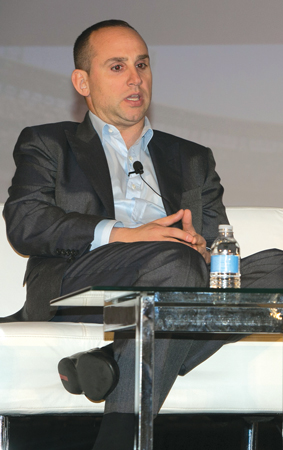 |
“We’re going to spend around $100 million on technology this year,” Rubin says.
Photo by: TONY FLOREZ PHOTOGRAPHY
|
■ Licensees tell me they are being forced to choose between you and Amazon in many cases, when they say Fanatics is not as good as Amazon …
RUBIN:
Our vendors can do business with whomever they want. That’s completely their choice. … They (Amazon) are not remotely taking care of the fan. You mention Amazon and you will get me on a tirade. There’s no greater enabler of counterfeit (licensed products) in the world than Amazon. We study their listings in licensed sports and between 50 and 70 percent of their (licensed product) listings were counterfeit on a daily basis during the (2016) fourth quarter. … You’ve seen a lot of noise against that in the last six months and that’s going to intensify.
■ The other comment we hear a lot from the sports licensing industry is that while you are building a great model for Fanatics, is it one that benefits consumers?
RUBIN: Our model is better for fans. Most people in stadium operations believe in charging substantially above retail for (licensed merchandise). We don’t believe in that. The (venue merchandise) business was built by (food and beverage) companies paying a high rev share and they rip the fan off. Now a fan takes a mobile phone and starts looking at pricing. We want to give consistent, appropriate pricing, and great value.
■ Certainly, there’s an associated concern that one company with more licensing rights across leagues would automatically limit choice and elevate pricing …
RUBIN: That will not happen. I sit in meetings and talk about adding more value. If you look at our new NBA or NHL (replica) jerseys, those are substantial steps forward from a quality perspective, and the prices didn’t go up. If anyone takes prices up and brings selection down, they’ll be dead on arrival.
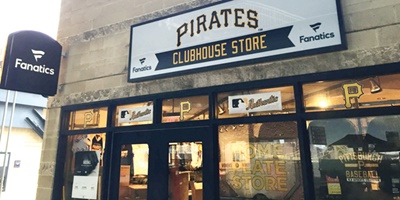 |
Fanatics’ in-venue store at PNC Park in Pittsburgh
Photo by: COURTESY OF FANATICS
|
■ Still, there are people in this business who think your model means the end of innovation …
RUBIN:
We’re the most innovative (sports licensing) company by far. If an industry hasn’t changed forever and things start to change, there will be some noise. Sports shouldn’t ever be a sleepy business and retail shouldn’t, either. … Look at the sports collectibles business: It had been kind of ruined by the internet and all the authenticity issues. We acquired (memorabilia seller) Mounted Memories when we bought Fans Edge. We solved a lot of their problems and that business has gone from a $10 million business to a $100 million business in less than five years.
■ That seems like a good jumping-off point to ask you about your plans for hard lines (non-apparel) licensed products.
RUBIN: We don’t do a good job there, but it’s a massive opportunity. There’s been less thought put into hard lines to date. It should be a bigger portion of our business. … Video games and trading cards are the biggest part of that business, and those are business we’re barely in today. The balance of hard lines we do a mediocre job in and that’s our opportunity.
■ You’ve invested a lot in online marketing as the brand has grown. Should we expect a bigger off-line marketing push from Fanatics?
RUBIN: We’ll spend close to $100 million in advertising the Fanatics brand this year — most of that online. We were testing TV ads with RSNs and some networks last year. Traditional media is a great way to grow the whole licensing industry, and we haven’t really taken our first at-bat with traditional media. In five years. I’d like our traditional media spend to be 50 times more. … But I don’t think we’re buying those (media assets) from the leagues. We have the assets we want from the leagues. I think we’ll be buying from the big media companies.
■ Did you pattern Fanatics after any particular model or brand?
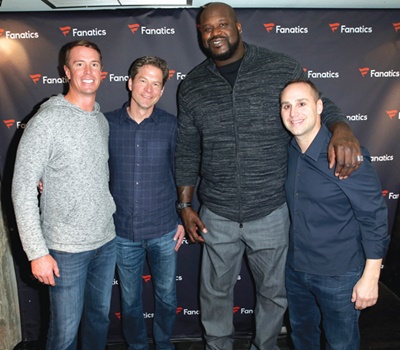 |
Rubin at Fanatics’ Super Bowl party last year with (from left) Atlanta Falcons quarterback Matt Ryan, Fanatics CEO Doug Mack and NBA hall of famer Shaquille O’Neal.
Photo by: GETTY IMAGES
|
RUBIN: What I got most wrong at my old company (GSI Commerce) was that I never loved our core business (of setting up e-commerce for companies), so I kept adding things. So we did the core business less well. When I restarted, I said that we will be maniacally obsessed on one business. We got into new businesses like wholesale, venue sales and international, but we got there by talking to leagues and team owners about what they need.
■ Next big growth steps are …?
RUBIN: Well, we already talked about technology and data to improve things as mobile e-commerce grows and using technology to personalize everything. We’re just starting in the business of running venue sales. We’re already the biggest, but we’re just starting. Multichannel integration is another big opportunity and we haven’t even cracked the surface. We just got into wholesale, but we expect it to be a big and vibrant business. …
International is not yet a moneymaker; it’s a massive investment for us today. We bought (European soccer e-commerce specialist) Kitbag as a foundational part of building our international business. … It’s a different landscape. The percentage of licensed (merchandise) that performance brands like Under Armour or Nike and Adidas make up outside of North America is like 70 or 80 percent versus 20 or 30 percent in North America, so we see a massive opportunity there. If we had the same assortment of products outside the U.S. as we do inside, our international business would double overnight.
■ Do you have sufficient manufacturing capabilities to support all the league rights you’ve picked up?
RUBIN: Here’s how we are like Amazon: We’re always adding capacity. But that’s the story of any growing business. You build it as you go.
■ Inevitably, that last question leads to the question of when and if you are buying VF’s Majestic (licensed sports) brand and its domestic manufacturing capabilities.
RUBIN: We’re never going to comment on anything in the future. … There’s rumors about us all the time.
■ Fanatics has reached a point now where it’s a wholesaler, and a retailer, a licensee, and now with enough rights to perhaps be considered a licensor of sorts. That sounds like a lot of conflicts.
RUBIN: To me, it’s not conflicted, it’s just the way the business has developed. Nike has a huge direct-to-consumer business and they have a huge wholesale business as well. Media companies do business with each other and they compete. I don’t think any company in 2017 that’s a big growth company won’t have those kinds of situations. It doesn’t feel the slightest bit unnatural to me.



